THE AIRPORTS
SOUTHERN CALIFORNIA
LOS ANGELES
LAX
1980s
Page 2

|
August 1981 Another important Asian carrier with important cargo links was Seoul, South Korean based Korean Air which has established its cargo division in 1971. The airline placed an order for the "Freighter" version of the successful Boeing 747 and with delivery of the first aircraft in 1978, the airline inaugurated the first Boeing 747F trans-Pacific cargo flights between Seoul and Los Angeles. Los Angeles was such a large market, that Korean Air Cargo opened its own air cargo terminal at the airport in 1981. Seen arriving during a summer evening and in flare for landing on Runway 24 Right is HL-7451, a Boeing 747-2B5F, delivered new to the airline in June 1980. |
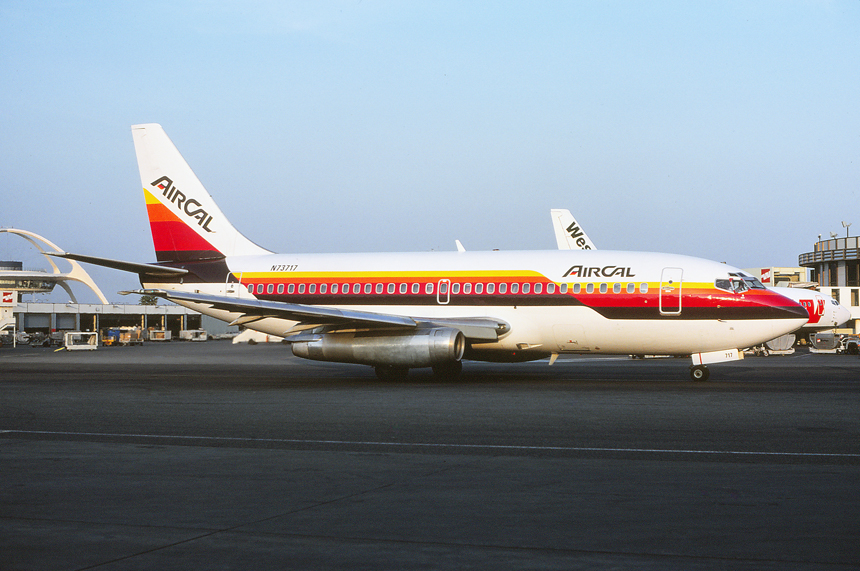
|
October 1981 Air California had only been serving Los Angeles for about a year when the airline was purchased by a pair of local Orange County investors and renamed Air Cal in April 1981. Operations continued to be expanded at LAX and flights to both San Jose and Oakland were soon started after the name change. Seen taxiing outbound toward Runway 25 Right for an early evening departure is N73717, a Boeing 737-2H4, on lease from Aloha Airlines. |
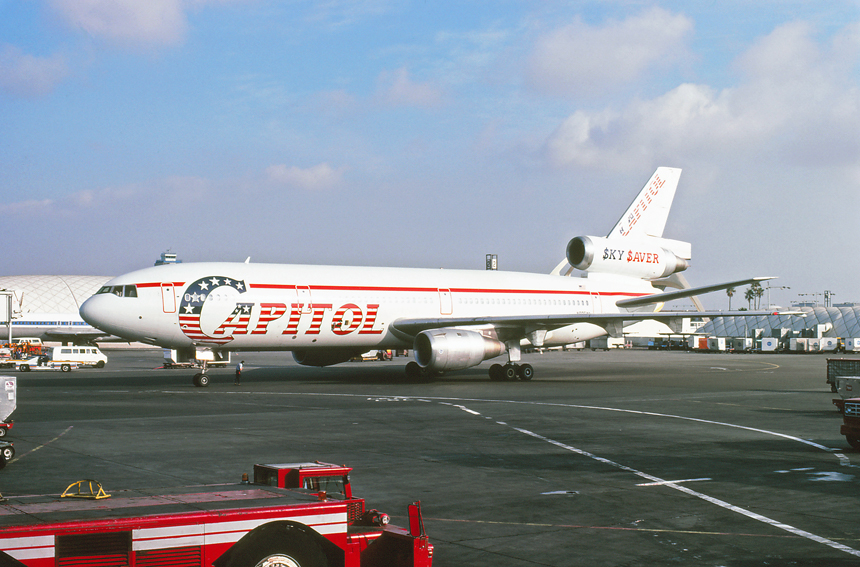
|
November 1981 Formed in 1946 as a military and passenger charter operation, Capitol Airlines became one of the largest airline charter services in the U.S. After the deregulation legislation in 1978, Capitol Airlines started low-fare scheduled service between Los Angeles and New York City initially with Douglas DC-8. Three Douglas DC-10s were than leased to increase capacity on the popular "$ky $aver" route included added service to Chicago. Taxiing inbound toward the gate at Terminal 2 on a fall afternoon is N905WA, a Douglas DC-10-10, originally with Western Airlines and leased by Capitol in July 1981. |
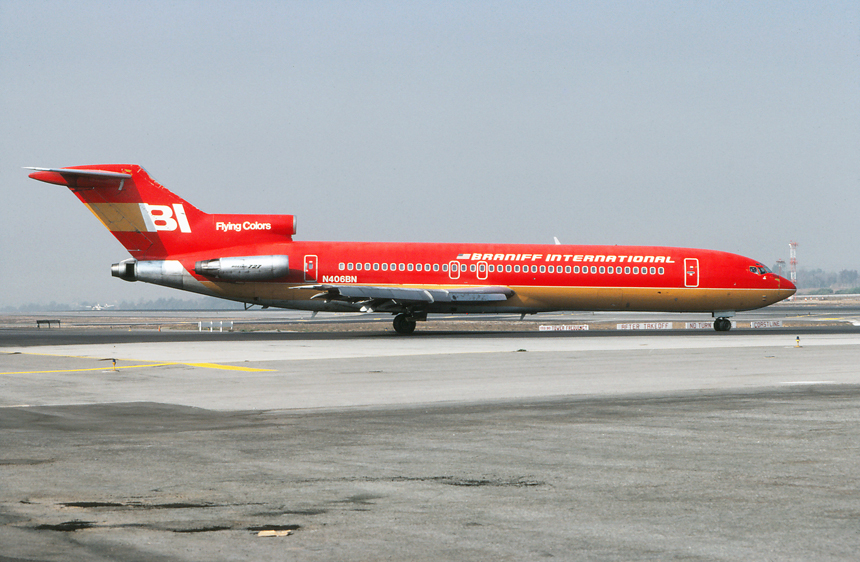
|
November 1981 Although, Braniff International Airways had been serving Los Angeles on just three flights to San Francisco, Lima, and Bogotá acquired in 1966 with the purchase of Panagra Airways, the airline expanded domestic operations in 1978. Taking advantage of deregulation Braniff added sixteen new cities across the U.S. in one day, and expanded operations at Los Angeles starting flights to Dallas-Ft. Worth, Honolulu, Oakland, and San Antonio. Proudly displaying the red and orange toned "Flying Colors" and holding short of Runway 24 Left for a morning departure is N406BN, a Boeing 727-291. |
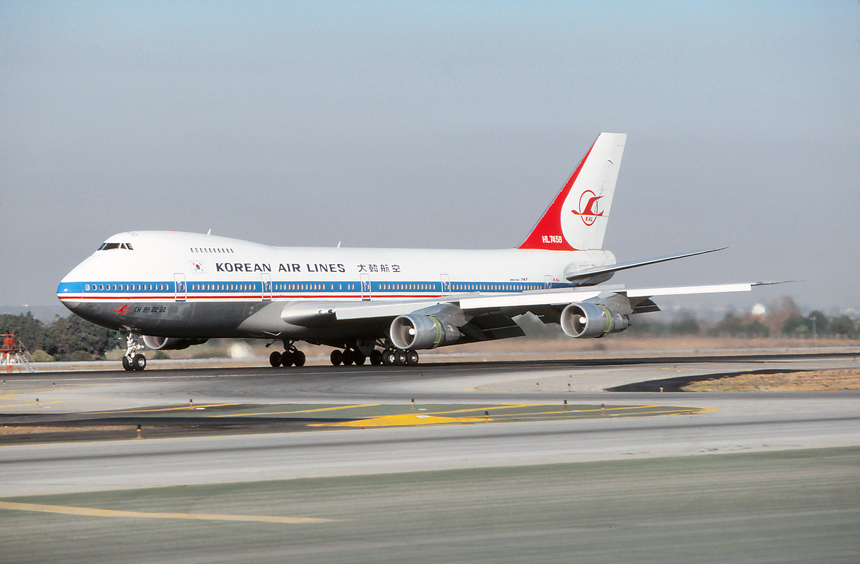
|
November 1981 Korean Air Lines placed the Boeing 747 in service during May 1973, for trans-Pacific flights on a Seoul-Honolulu-Los Angeles routing. By 1980, the Boeing 747 was providing four weekly non-stop flights between Los Angeles and Seoul, South Korea and maintaining an important link between the two countries. Seen rolling out on Runway 24 Left after an early evening arrival is HL-7458, a Boeing 747-2B5BF, delivered new to the airline just seven months earlier in April 1981. |
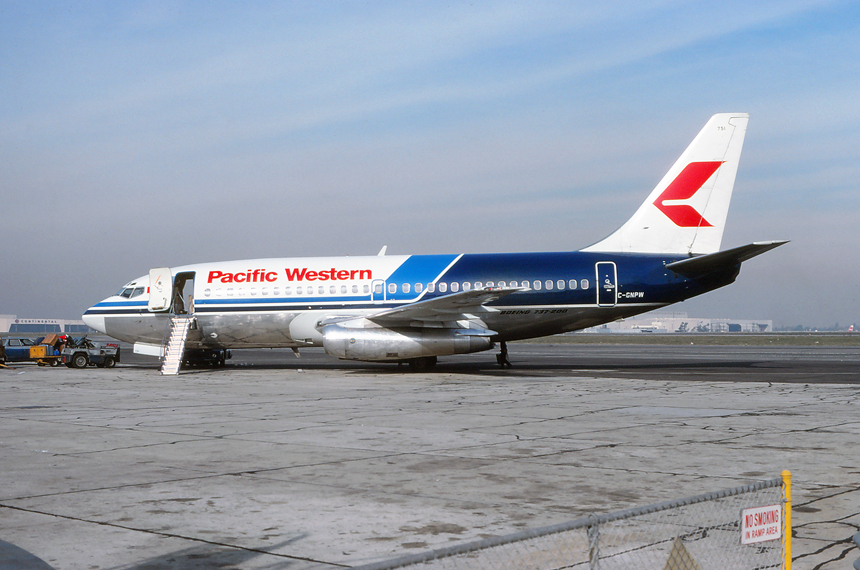
|
January 1982 Vancouver, Canada based Pacific Western Airlines was started in 1953, with the consolidation of smaller flight companies. The airline was granted license to provide passengers and cargo services to many locations in the western and northern areas of Canada. As its scheduled operations grew, so did its charter and tour services. In 1970, the airline was granted its only scheduled route to the United States on a service between Seattle and Victoria, British Columbia. As a popular tour and charter operator from the colder environs of Canada, it was common to see the airlines Boeing 737 in warmer climates including Los Angeles especially during the winter season. Parked at the Imperial Terminal during a charter flight is C-GNPW, a Boeing 737-275 delivered new to the airline in July 1980. |

|
January 1982 Metro International Airlines was a charter and scheduled passenger airline that was formed as a subsidiary of Flying Tigers which started operations in January 1980. Scheduled services were started on a New York-JFK-Brussels-Tel Aviv routing followed by flights between New York-JFK and Los Angeles. Within two years Flying Tigers taking a loss from the attempt at passenger operations sold the airline in 1983, to the newly formed Tower Air based in New York. Seen taxiing along Taxiway Foxtrot is N748TA, a Boeing 747-212B, originally delivered to Singapore Airlines in August 1973. |
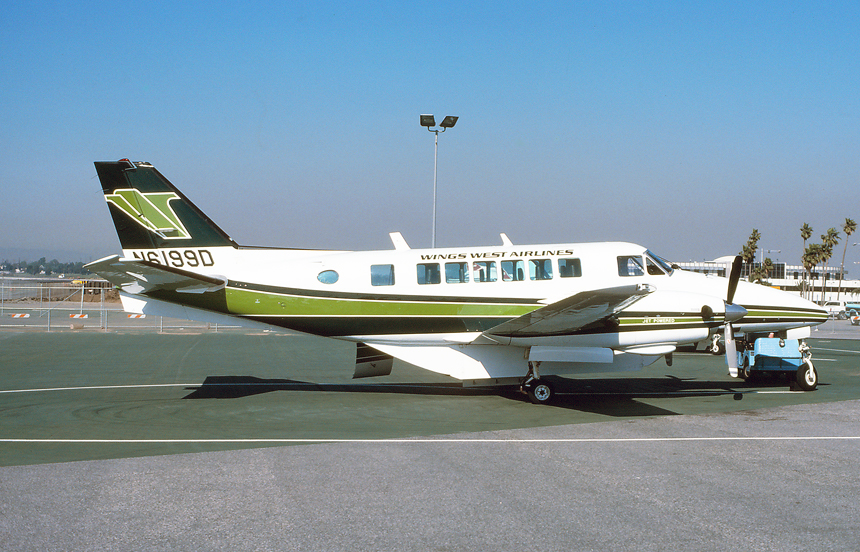
|
February 1982 Taking advantage of the Deregulation Legislation, Wings West Airlines was started to provide commuter service from Santa Monica Airport to Mammoth Lakes in November 1979. Seeing an opportunity for growth, the airline acquired both the Beech 99 and Swearingen Metroliner to increase capacity on new routes. In June 1981, the airline started service into Los Angeles International Airport with flights to both Bishop and San Luis Obispo. With the addition of turboprop equipment, the airline expanded quickly at LAX, adding service to Mammoth Lakes, Oxnard, Santa Maria, and Yuma. Parked at the commuter ramp and being ready for an afternoon departure is N6199D, a Beech C-99 Airliner. |

|
April 1982 Eastern Air Lines was the North American launch customer for the Airbus A-300 after the airline signed a lucrative deal to "test" four aircraft starting in December 1977. Eastern was so pleased withe the capacity and operating economics of the A-300 that they placed an order for an additional nineteen aircraft. Although initially used on the Florida-Northeast corridor flights, the A-300s were eventually placed on transcontinental services in 1982 such as Los Angeles to Atlanta and New York-JFK. Seen taxiing onto Runway 24 Left for a morning departure on a bright spring day is N225EA, an Airbus A-300B4-203. |
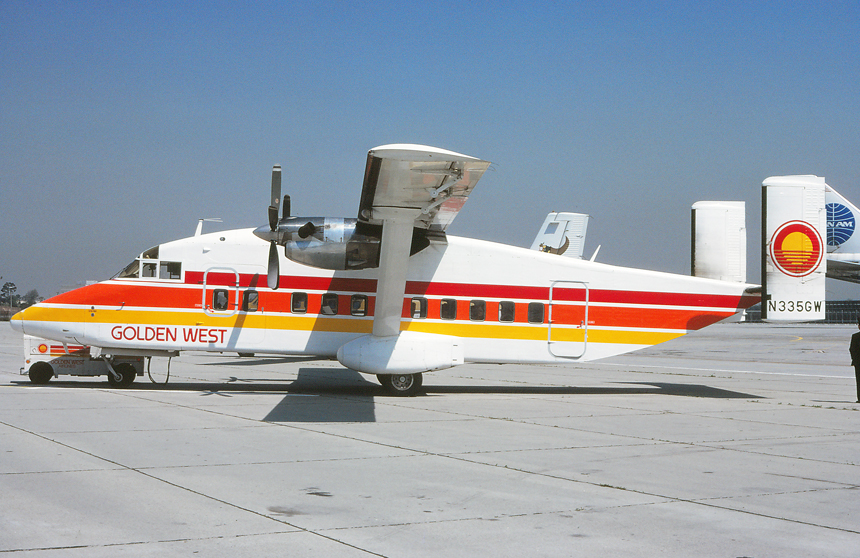
|
April 1982 The Shorts SH-330 "wide-bodies" had allowed Golden West Airlines to expand services and increase capacities but were slowly being displaced by the newer de Havilland DHC-7 aircraft on trunk routes. With a fleet of five Shorts SH-330s, the now older plane was still being used to supplement capacity in 1982 and was seen on flights from Los Angeles to Ontario, Oxnard, Santa Ana-Orange County, and San Diego. Dressed in the new corporate colors and parked on the ramp is N335GW a Shorts SD-330-100 and the last example delivered to the airline in July 1981. |

|
May 1982 Aspen Airways continued to provide service into Los Angeles with flights to both Burbank and Lake Tahoe using the Convair 580 turboprops. In 1981, with Golden West Airlines starting service into Lake Tahoe, Aspen no longer had the route monopoly to the mountain destination and after further losses pulled out of the California market in the summer of 1983 to focus its efforts on its Denver base of operations. Seen "over-the-numbers" for landing on Runway 24 Right is N5815, a Convair CV-580, originally delivered to Braniff International Airways as a Convair CV-340-32. |
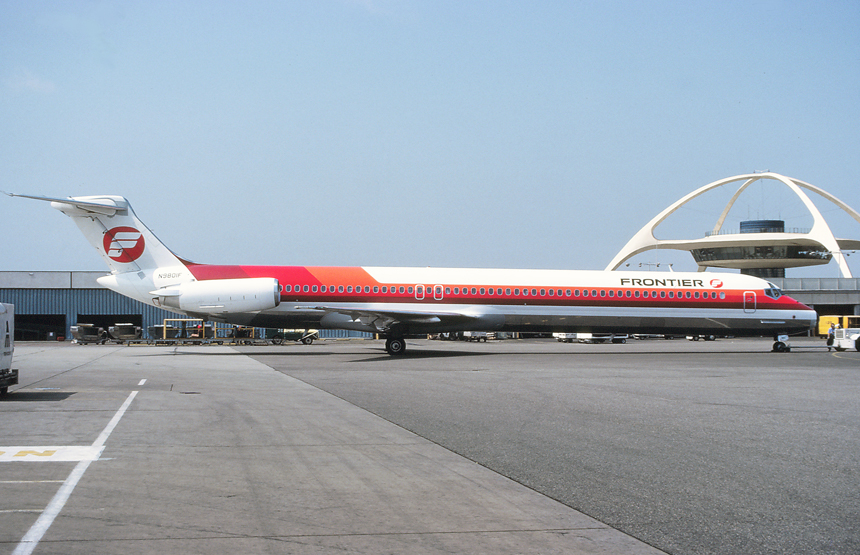
|
June 1982 Denver based Frontier Airlines was finally able to enter the lucrative LAX market when in May 1981 flights were started between Los Angeles and Denver using the Boeing 737-200. When Frontier received its first McDonnell Douglas MD-80s in April 1982, the new 147-seat, Stage II aircraft were placed on the higher density, noise sensitive service into both Santa Ana-Orange County Airport and Los Angeles International Airport. Seen being prepared to push back from the gate at Terminal 6 is N9801F, a McDonnell Douglas MD-82, the first of the type delivered to the airline on April 22, 1982. |

|
July 1982 Korean Air Lines was another Asian carrier that would take advantage of the ultra long-range Boeing 747SP "Special Performance" and took delivery of two of the type in 1981. With a capacity of 252-passengers, the SP was specifically to be used on trans-Pacific non-stop flights from Seoul to the West Coast cities of San Francisco and Los Angeles. Seen taxiing back toward the International Terminal after having landed is HL7456, a Boeing 747-SPB5, delivered new to the airline on January 22, 1981. |
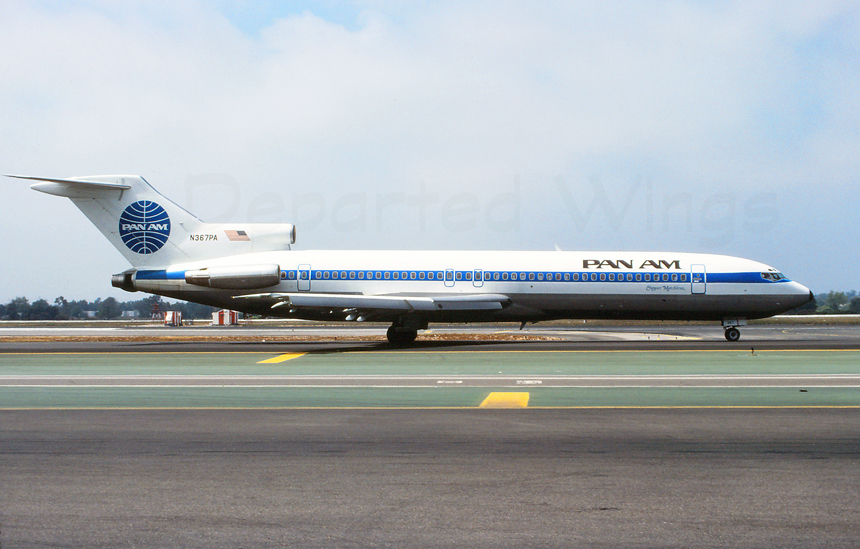
|
July 1982 After the purchase of National Airlines in 1980, Pan Am acquired an additional Boeing 727s and even ordered more aircraft to support the domestic route network it assumed from National. From Los Angeles in 1982, Pan Am was using the Boeing 727 on domestic services to Houston-Intercontinental, New Orleans, and Las Vegas, and on the international route to Mexico City. Seen taxiing toward Runway 24 Left for a mid-morning departure on an overcast day is N367PA "Clipper Matchless," a Boeing 727-221, delivered new to the airline a few months earlier in April 1982. |
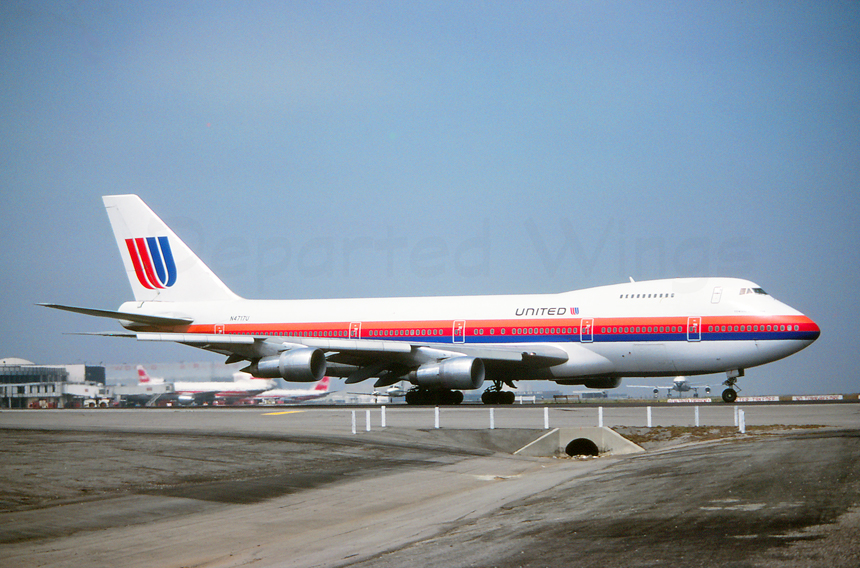
|
July 1982 United Airlines' "heavy" Boeing 747s were a daily visitor to Los Angeles, and were used extensively on trans-Pacific services to Honolulu, Hawaii with no less then five daily departures using the "Jumbo Jet." With a capacity of just over 400-passengers, United's Boeing 747 was also scheduled on the popular daily flights to both Chicago and Denver. Seen holding short of Runway 26 Left for a morning departure to Honolulu is N4717U, a Boeing 747-122. |
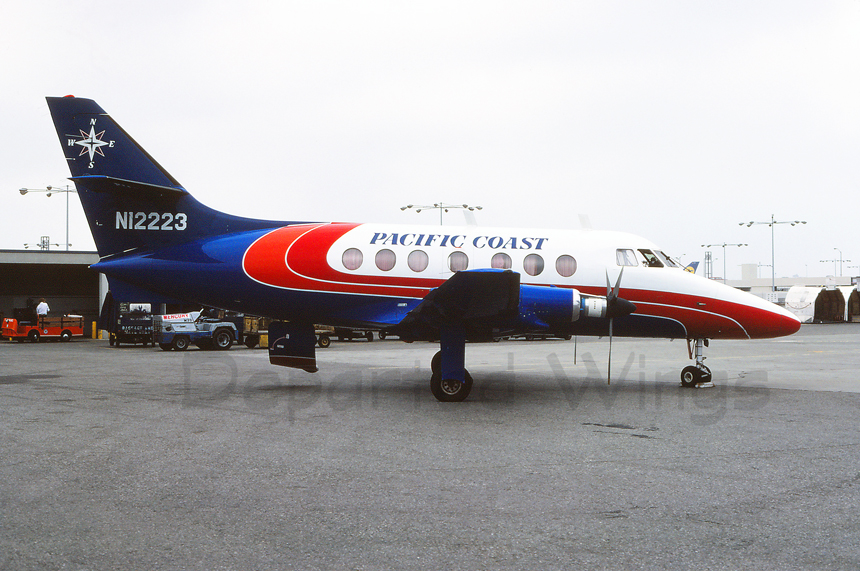
|
July 1982 Originally founded as Apollo Airways in 1969, based in Santa Barbara, a reorganization in March 1982, saw the airline renamed as Pacific Coast Airlines to better reflect its operating routes. Using a small fleet of Handley-Page Jetstream turboprop aircraft, Pacific Coast was flying from eight cities in California and to Las Vegas, Necada including non-stop services from Los Angles to both Santa Barbara and Bakersfield. Seen parked on the ramp at Terminal 5 and awaiting another load of passengers on an overcast afternoon is N12223, a Handley-Page HP.137 Jetstream Mk I. |

|
July 1982 Martinair Holland started operations in 1958 using a Douglas DC-3 on air taxi services around the Netherlands. During the 1960s Martinair acquired Lockheed Electra's and its first jet aircraft; the Douglas DC-8 from KLM, which then owned a 25% stake in the airline, to start passenger charter flights. Douglas DC-10s were introduced in 1973 and provided the airline a global reach for its charter operations. Los Angeles was a popular destination for both summer and winter charter flights, and PH-MBT, a Douglas DC-10-30(CF), taxis toward the Imperial Terminal after having landed on a summer charter flight. |
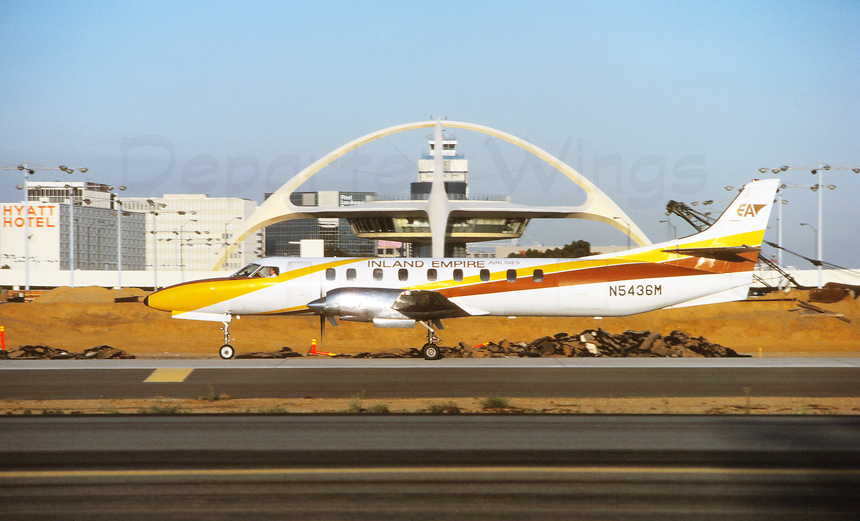
|
September 1982 After deregulation in 1978, many mainline airlines that had been subsidized for flying to smaller cities stopped service to these destinations with sometimes no other carrier to continue operations, leaving some cities with no commercial air service. Many "commuters" were started to take the place of the larger carriers and continue to serve smaller stations. Inland Empire Airlines was once such carrier and started service to the Central California city of Visalia in 1979, from both San Francisco and Los Angeles before United Airlines halted services. By 1982, Inland Empire had grown to serve eleven cities in California and flights from Los Angeles to both Visalia and Fresno. Seen taxiing along Taxiway Sierra enroute to Runway 26 Left for an evening departure is N5436M, a Swearingen SA-226TC Metroliner. |

|
October 1982 In the post deregulation decade, many airlines would start operations hoping to fill a void in a niche market or prove a low cost option. The Hawaii Express was formed to provide high-capacity, low fare service on the popular Los Angeles-Honolulu route. Initially using a single leased Boeing 747, the airline started service in August 1982, much to the dismay of traditional carriers on the route, United Airlines, Continental Airlines, and Western Airlines. With a capacity of 491-passengers and fares as low as $89 one-way, The Hawaii Express was set to "stand-alone" in the face of the major carriers on the Honolulu route. Seen taxiing up to the hold short line to Runway 26 Left for a morning departure to Honolulu, is N355AS "Jason Everest," a Boeing 747-143. |
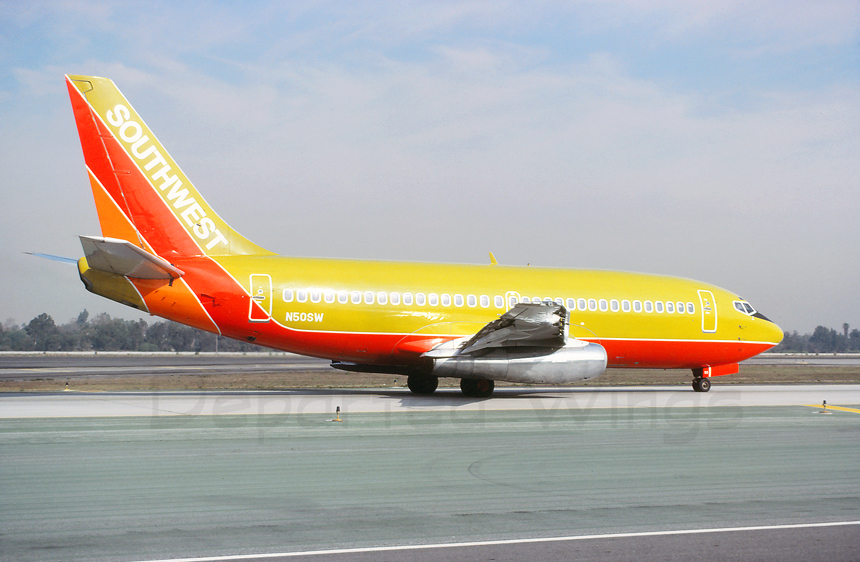
|
December 1982 Texas based low cost, no frills carrier, Southwest Airlines entered the West Coast market in 1982 starting service to Los Angeles on September 18 of that year with three daily departures to both Phoenix and Las Vegas. In direct competition with established carriers in the market, including Pacific Southwest Airlines PSA and Western Airlines, Southwest made a powerful impact and soon increased flights and destinations from Los Angeles. Taxiing toward Terminal 1 after having landed is N50SW, a Boeing 737-2H4. |
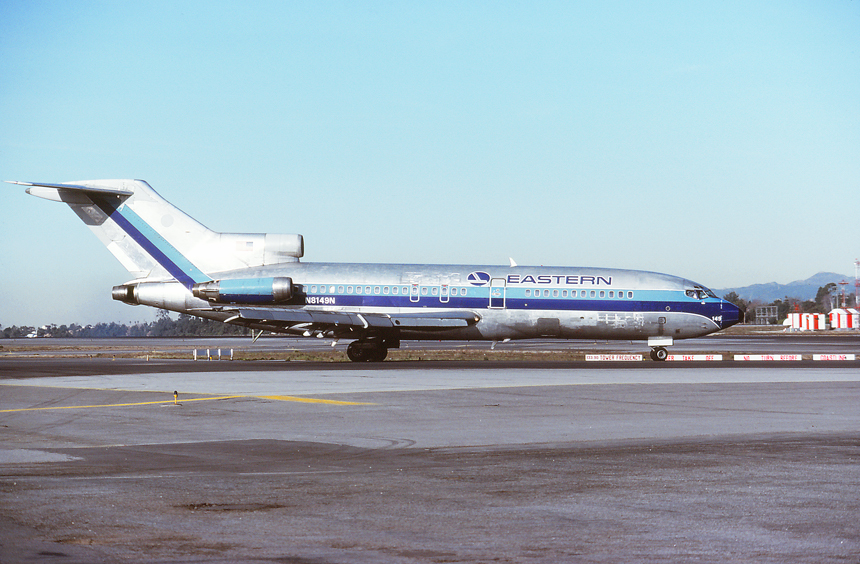
|
January 1983 Although Eastern Airlines flew its "heavy" aircraft between Los Angeles and its hub destinations, in 1982 service was started between Los Angeles and Houston-Intercontinental Airport which saw the Boeing 727 used on the daily flights. Seen holding short of Runway 26 Left for an early morning departure is N8149N, a Boeing 727-25, delivered new to the airline on March 25, 1966. |
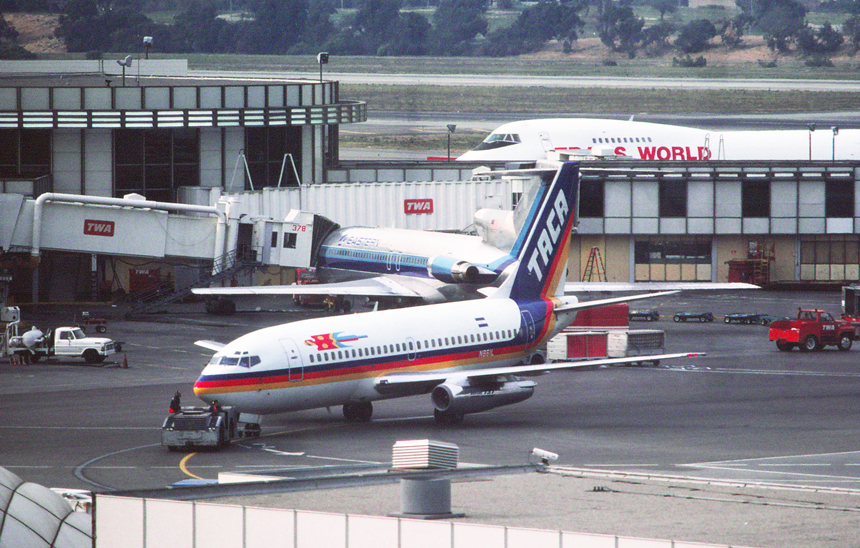
|
February 1983 In 1982, Transportes Aereos Centroamericanos, commonly known as TACA started operations into Los Angeles and became the first airline to start non-stop service to San Salvador, El Salvador. What was unique about this four-day-a-week service is the airline flew the 2100-mile route, non-stop with a Boeing 737, quite the distance for the Boeing twin-jet! The introduction of service to San Salvador opened a new market for Central American and it's connections to Los Angeles. Seen being pushed back from the gate at Satellite 2 for a morning flight southbound is N861L, a Boeing 737-2Q8. |
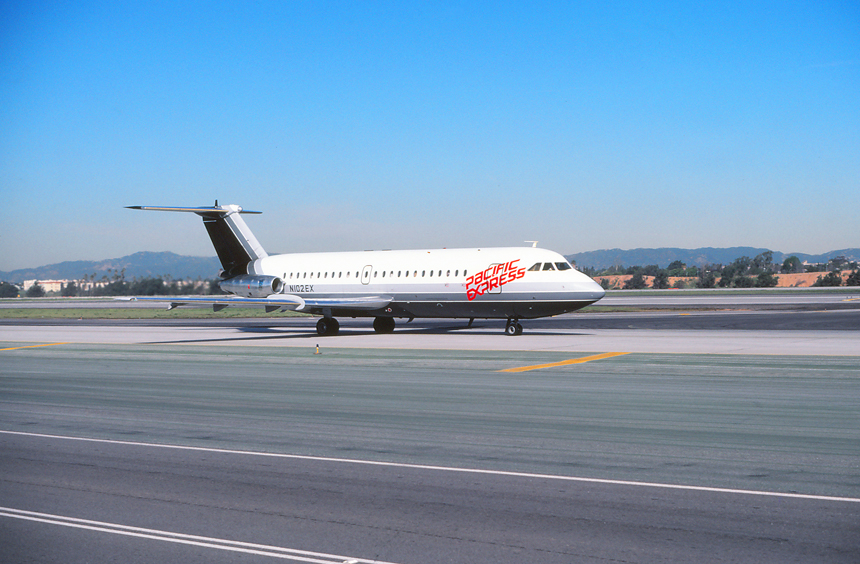
|
February 1983 Pacific Express was an airline that was started in 1981 to provide low-cost services to points in the West based upon the successful model employed by Pacific Southwest Airlines-PSA. The airline choose the British built Twin-Jet, BAC-1-11 as the aircraft of choice when flights were started from the Bay Area to Palm Springs. Services into Los Angeles were started in April 1982 with flights to Palm Springs, San Francisco, and Stockton. Seen taxiing toward the terminal after having laded on a bright winter morning is N102EX,a British Aerospace BAC-1-11-201AC. |
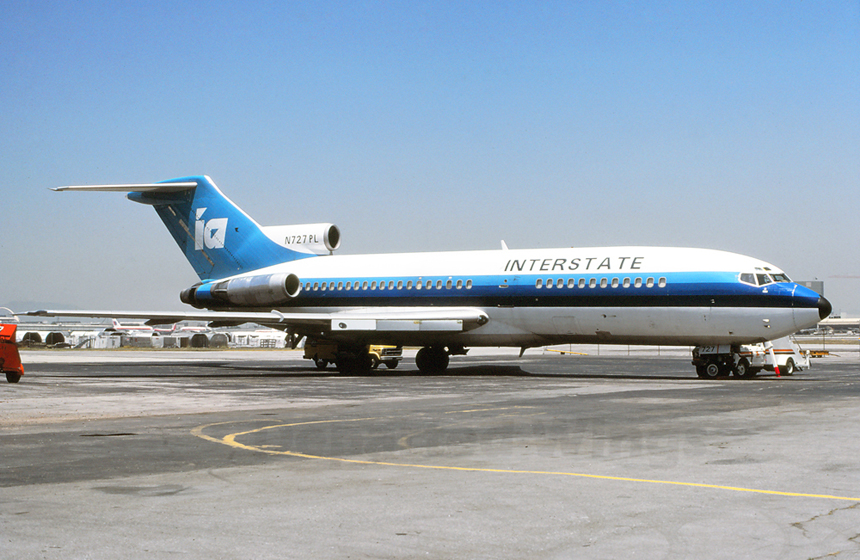
|
May 1983* Interstate Airlines was created in 1978, post the air cargo deregulation legislation to fly contract and charter cargo services. With a base of Willow Run Airport, the carrier started with Convair CV-580 turboprops, then initially purchased three Boeing 727 freighter conversions for jet cargo service for both DHL and Emery Worldwide contracts. Seen parked on the south cargo ramp is N727PL, a Boeing 727-22C, purchased by Interstate Airlines on November 10, 1981. |
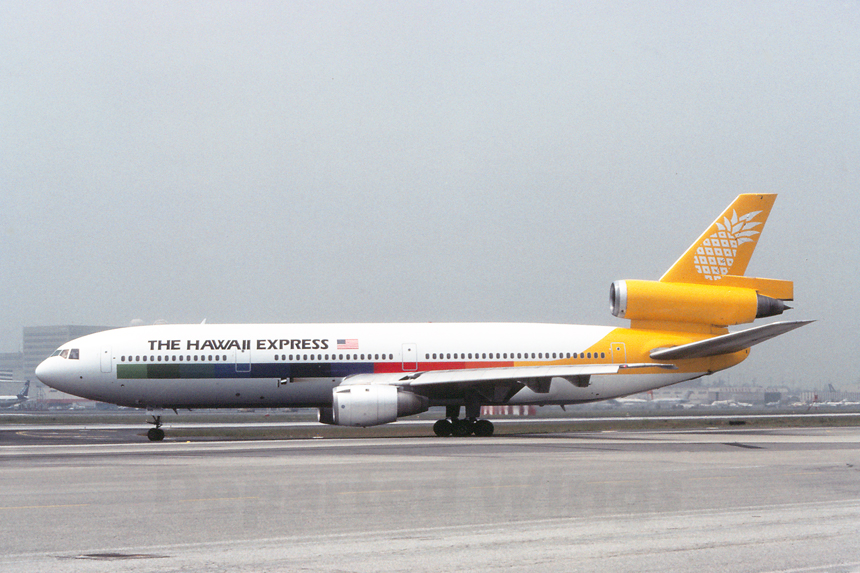
|
June 1983* After only six months of operations and with fierce competition in the Los Angeles-Honolulu market with the likes of established carriers such as Western Airlines, Continental Airlines, and Northwest Orient, The Hawaii Express traded in the Boeing 747 for a pair of Douglas DC-10s in April 1983. With the two smaller aircraft the airline was able to increase service to three daily round-trips, as well as planning to expand with additional destinations. Seen approaching Runway 25 Right for a morning departure under overcast skies is N905WA, a Douglas DC-10-10, being leased from International Air Leases on April 5, 1983. |
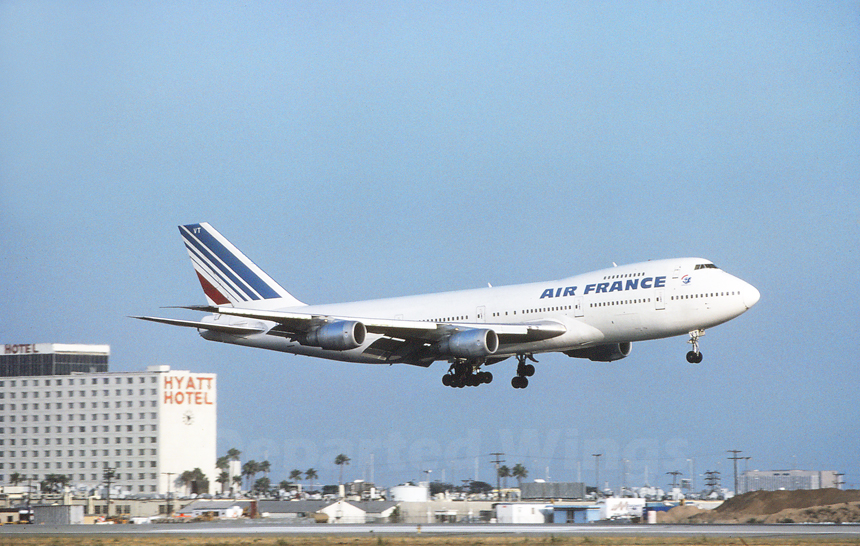
|
July 1983* Air France introduced their well recognized "tri-color" logo was introduced in 1976 to help celebrate the introduction of the famed British Aerospace Concorde. The colors combined the elements of the French national flag and wings of the hippocampus, a symbol used by the airline beginning in 1933. During the early 1980s Air France had increased service to Los Angeles from Paris Charles de Gaulle to six times weekly using the Boeing 747s. Seen over-the-numbers for landing on Runway 24 Right during an evening arrival from Paris is Air France Flight 003, a Boeing 747-228BM, registered F-BPVT and delivered new to airline on September 30, 1977. |
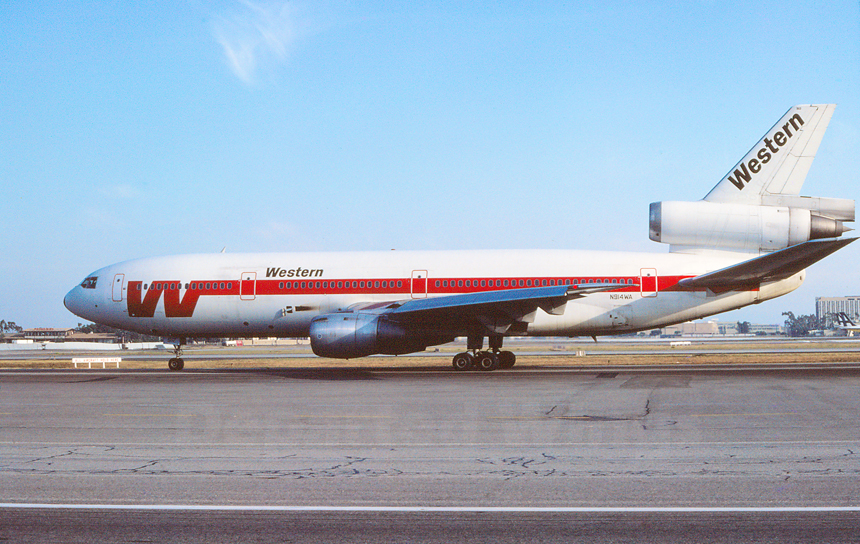 July 1983* July 1983*By 1983, Western Airlines was operating a fleet of eleven Douglas DC-10s on its more dense services. Los Angeles was seeing the "Heavy 10" on scheduled flights to Honolulu, Salt Lake City, Seattle, and Vancouver, Canada. Seen taxiing toward Runway 24 Right for an evening departure is N914WA, a Douglas DC-10-10, delivered new to the airline on May 12, 1980. |
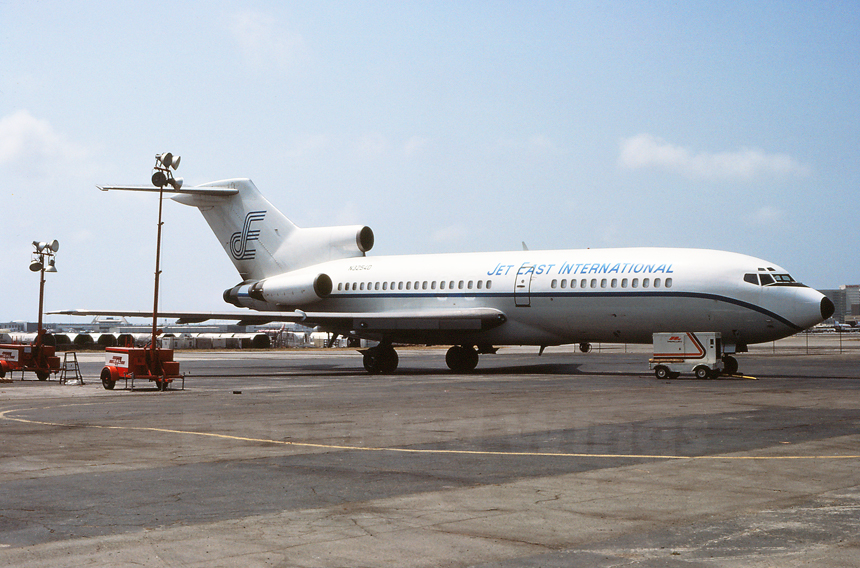
|
July 1983* Jet East International was established in early 1983 as a contract and charter cargo airline based in Austin, Texas. A single Boeing 727 was initially purchased in 1983 to provide air cargo service for DHL Airways. Eventually Jet East International would operate over twenty Boeing 727s in various cargo and passenger charter configurations. Seen parked on the south cargo ramp is N3254D, a Boeing 727-155(C), originally delivered to Executive Jet Aviation in 1967. |
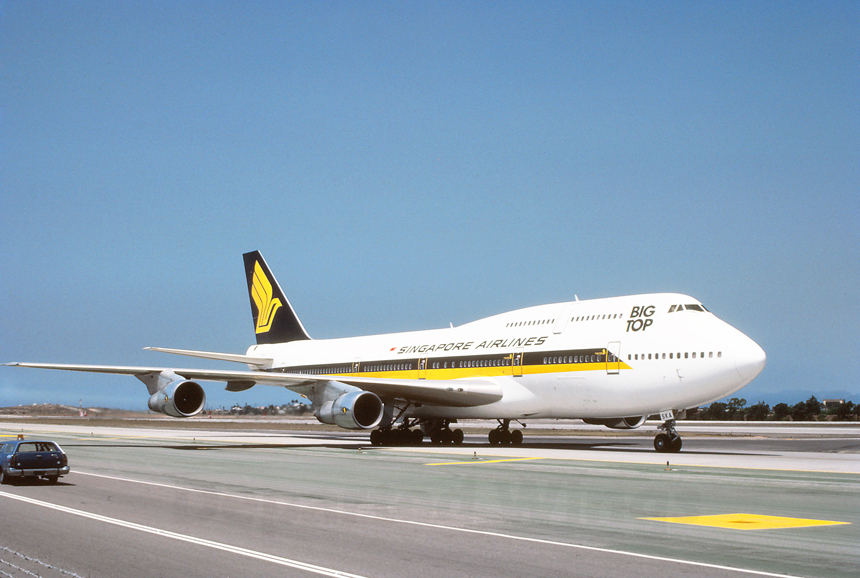
|
August 1983* Singapore Airlines spent many years during the 1970s trying to secure rights to start service to the United States as part of its planned expansion. Service to San Francisco was finally started in July 1979. Los Angeles was added on July 2, 1980 using their brand new Boeing 747 "Super-Bs" on the thrice-weekly Singapore-Taipei-Honolulu-Los Angeles service. Within a few years the Boeing 747-300 was placed on the now one-stop Singapore-Tokyo-Los Angeles routing. Seen taxiing back to the terminal along Taxiway Uniform after a trans-Pacific flight is, 9V-SKA, a Boeing 747-312. |
Los Angeles-LAX: Los Angeles-LAX Main Index
Back to: The Airports